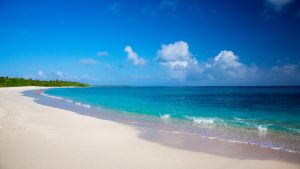By Joshua Mcdonald

The United Nations announced recently that 50 countries had ratified the Treaty on the Prohibition of Nuclear Weapons (TPNW), triggering its entry into force by January 22, 2021, despite protests from the United States, its allies and other nuclear powers.
Seventy-five years on from the devastating nuclear attacks on Hiroshima and Nagasaki, in the closing days of World War Two, the ratification by Honduras, pushed the treaty across the line.
While Japan has not ratified the treaty, plenty of other nations impacted by the development, stockpiling and testing of nuclear weapons, have. Among them are a majority of the Pacific Island nations, including the Cook Islands, New Zealand, Palau, Kiribati, Samoa, followed by Fiji, Nauru, Niue and Tuvalu. Papua New Guinea is expected to ratify in the coming months.
During the 1950s and ‘60s, more than 300 nuclear weapon tests were conducted by colonial powers in the Marshall Islands, Kiribati, Australia and French Polynesia.
Notably absent from the treaty is Australia, despite the British government having conducted a series of nuclear weapon tests in the country between 1952 and 1963.
Authorities forced Australia’s indigenous population to leave the area where testing was carried out, but many remained nearby, hoping to return one day, and were consequently exposed to high levels of radiation, which was later linked to significant health problems.
“We want nuclear weapons permanently banned and the uranium that can create them left in the ground,” Aunty Sue Coleman-Haseldine, a Kokatha-Mula woman from South Australia, who was subjected to nuclear fallout told a UN conference in 2014. “If you love your own children and care for the children of the world, you will find the courage to stand up and say ‘enough.’”
While Australia has tried to come to terms with its nuclear past, recent political leaders have been concerned that by signing or ratifying the ban treaty, they would effectively be tearing up their alliance with the United States and undermining their own security. Such is the case in Japan, too. Former Japanese Prime Minister Abe Shinzo said the treaty “was created without taking into account the realities of security.”
One of the most catastrophic tests conducted in the Pacific was on Bikini Atoll, in the Marshall Islands, where in 1954 the largest ever nuclear weapon was tested by the United States – estimated to be 1,000-times more powerful than the explosions at Hiroshima and Nagasaki.
According to a report for the International Campaign to Abolish Nuclear Weapons, people on nearby atolls were exposed to the radioactive fallout.
“People were playing with the fallout as it fell from the sky,” said Rinok Riklon, who was 14 years old at the time. “We put it in our hair as if it was soap or shampoo. But later I lost all my hair from it.”
In 2014, the Marshall Islands took all nine nuclear-armed countries to the Hague to pursue negotiations for the total elimination of nuclear weapons, but the International Court of Justice dismissed the lawsuits in October 2016. The Marshall Islands has since spearheaded the U.N. initiative to prohibit nuclear weapons.
Even after the end of nuclear testing in the Pacific, citizen groups across the region have continued to demand nuclear powers address the health and environmental impacts of past nuclear activity.
On the Marshall Islands’ Enewetak Atoll is the Runit Dome or as it’s known locally, “The Tomb” — a concrete dome encapsulating more than 3.1 million cubic feet, or 35 Olympic-sized swimming pools, of U.S.-produced radioactive waste.
“How can it [the dome] be ours?” Hilda Heine, the then-president of the Republic of the Marshall Islands told the LA Times last year. “We don’t want it. We didn’t build it. The garbage inside is not ours. It’s theirs”
The most recent report on the Runit Dome by the U.S. Department of Energy states that “the dome is not in any immediate danger of collapse or failure” and “is still serving its intended purpose.” The report did admit, however, that the dome is leaking radioactive material into the sea.
The U.S. government’s unofficial stance has been that the dome is now the responsibility of the government of the Marshall Islands.
A recent book by British journalist Jon Mitchell, “Poisoning the Pacific,” is based on more than 12,000 pages of U.S. documents that detail how military operations contaminated the Pacific with radioactive waste and chemical weapons such as Agent Orange.
“US authorities have repeatedly tried to cover up contamination. Through lies, disinformation and attacks on reporters,” Mitchell told the Guardian. “I have experienced the pressure firsthand.”
As the TPNW treaty neared 50 members — the number needed for it to enter into force — the Trump administration urged countries that had already ratified to withdraw their support,
In a letter sent to signatories, the U.S. government said, “although we recognize your sovereign right to ratify or accede to the Treaty on the Prohibition of Nuclear Weapons, we believe that you have made a strategic effort and should withdraw your instrument of ratification or accession.”
No comments:
Post a Comment